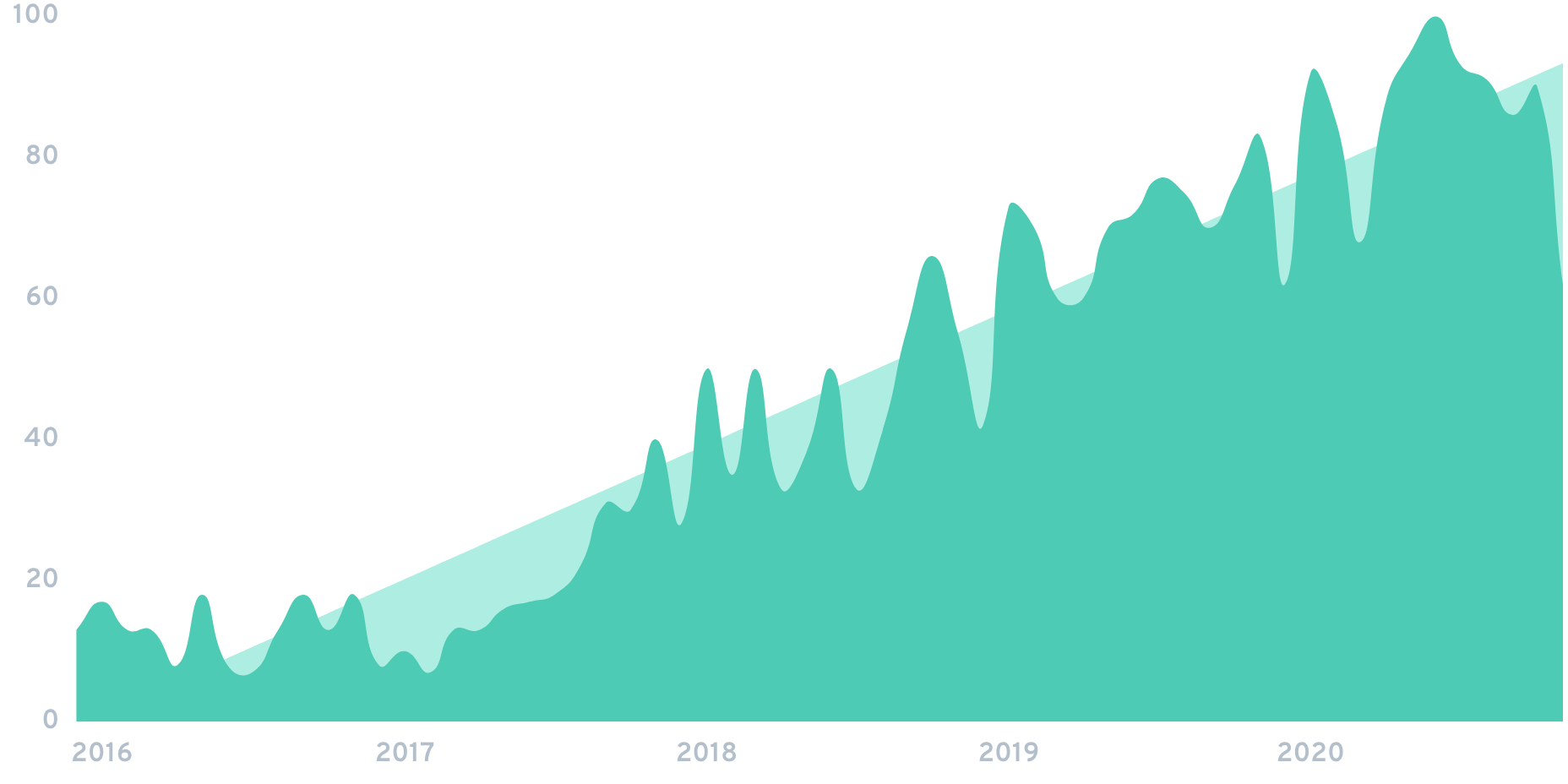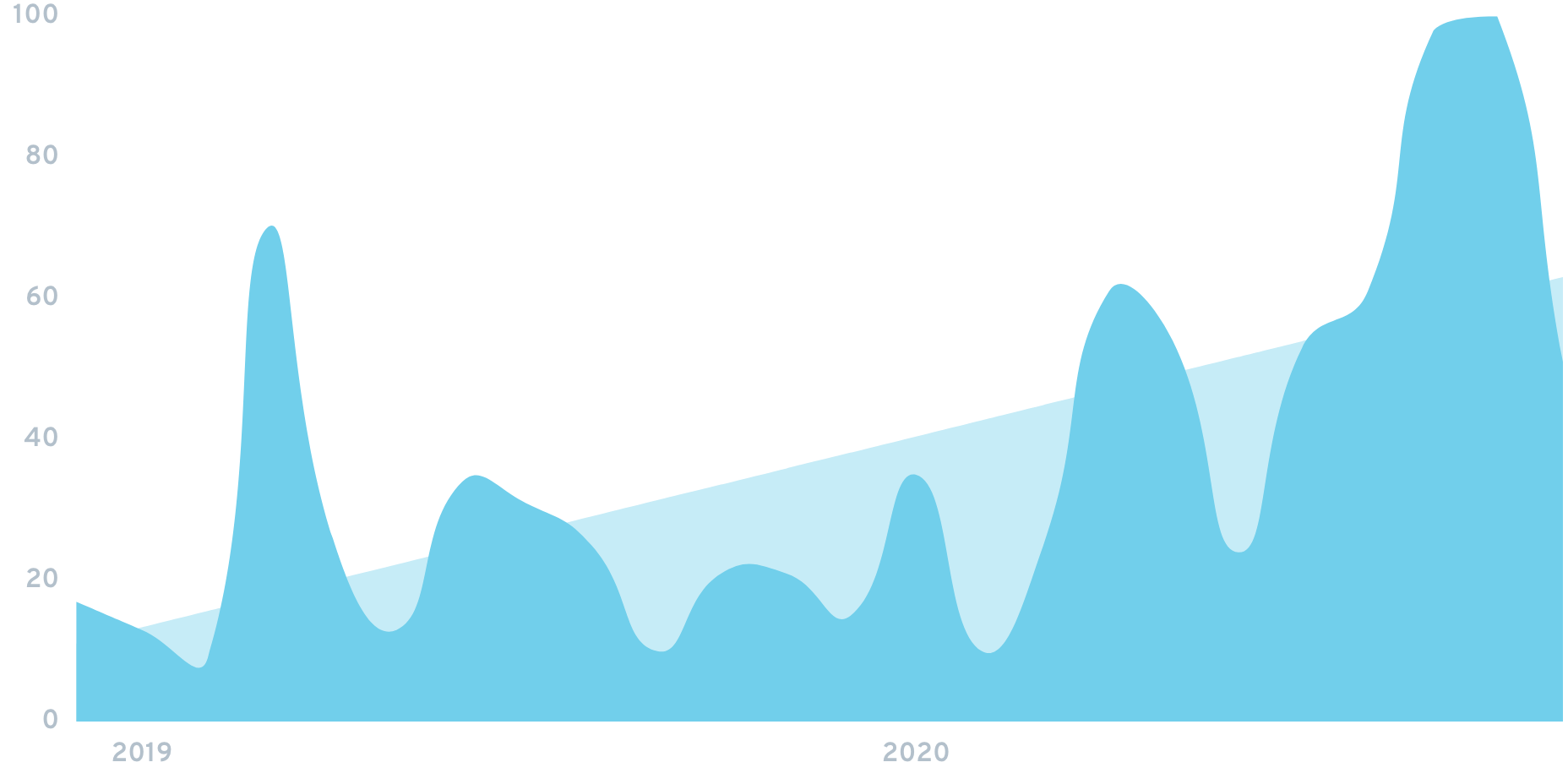Exploding Topics: TimescaleDB, Backyard Offices, and Two More Growing Trends
Hey fellow IHers,
Here are some rapidly trending search topics (with insights + analysis) to take advantage of.
1. Timescale

TimescaleDB is an open source database for time-series data. With optimizations specifically geared for time-sequenced data, it has the potential to achieve 10-100x faster query speeds.
Timescale launched in 2017. At that time, there were already several established time-series databases available, like InfluxData’s InfluxDB.
TimescaleDB stood out largely because it’s built on the massively popular Postgres SQL database system. According to StackOverflow's developers survey, Postgres was the 2nd most popular database in 2020. Which makes Timescale accessible to the thousands of developers already familiar with SQL. And with 543,710 active TimescaleDB databases, this strategy seems to be working.
What’s next:
Timescale is part of the “by developers for developers software” meta trend. With 24M developers worldwide, there’s growing demand for software aimed at developers like WakaTime, Istio, Jupyter and tmux.
Get weekly trends and insights in your inbox:
2. Backyard Office

A backyard office is outdoor space adapted into an area suited to working from home.
The backyard office trend started pre-pandemic. But interest in making or purchasing prefabricated backyard offices exploded once millions started working from home for the first time.
(In fact, one LA-based manufacturer reports that sales for their prefab backyard offices have increased by 250% since mid-April).
Depending on features (like plumbing), a typical prefab backyard office costs anywhere between $10k-$30k.
What’s next:
Backyard offices are part of the WFH Equipment meta trend. 4 out of 10 Americans now work from home, according to Stanford University. Which has led to booming interest in office-grade equipment that can be used at home. Other examples of this trend include blue light glasses, ergonomic chairs, laptop stands and noise-cancelling headphones.
3. Vital Proteins

Vital Proteins is a supplement company known for its line of collagen products.
The company had gone from zero to $150M in gross annual revenue in its first 5 years. And sales increased by 50% during the pandemic. Putting them on track to generate approximately $250M this year.
This exponential growth is likely why Nestlé Health Science acquired a majority stake in Vital Proteins in June. Financial terms of the acquisition weren’t disclosed. However, the company was valued at approximately $1B around the time of the sale.
What’s Next:
Vital Proteins is part of the Collagen Explosion metatrend. The collagen industry is currently worth $4B. And Grand View Research expects the space to grow to $6.5B by 2025. Other examples of this trend include marine collagen, vegan collagen, and collagen hand cream.
4. Beanstox

Beanstox is a robo advisor founded by Shark Tank’s Kevin O’Leary. In other words: Beanstox automates investing tasks, like asset allocation and portfolio management.
O’Leary’s mobile app launched on StartEngine, a crowdfunding site that provides equity to backers. And it raised $1.05M on a $15M valuation.
Beanstox is monetized via a $5 monthly fee as well as a 0.25% management fee for accounts with assets over $25k.
What’s Next:
According to InvestorPlace, total assets under management for robo-advisors may reach $16 trillion by 2025. And the number of people that manage their money with a robo advisor is expected to reach 40 million during that same timeframe. Besides Beanstox, growing robo advisor companies include Betterment, Wealthsimple, Sofi, and Ellevest.
 Post-launch lesson: traffic came, activation didn’t
Post-launch lesson: traffic came, activation didn’t
 I Stopped Browsing Reddit Randomly. Here's the Keyword Monitoring System That Actually Gets Me Customers.
I Stopped Browsing Reddit Randomly. Here's the Keyword Monitoring System That Actually Gets Me Customers.
 For indie hackers: Outsource marketing or do it yourself?
For indie hackers: Outsource marketing or do it yourself?

I see the future already- this will start out as my man cave for getting work done and it will end up as the doghouse I get banished to when I piss off the wife 😂
Hahaha, fantastic 🤣
If I were starting from scratch today, I might start something in the developer tools space. Not building a new developer tool, but catering to developers who are trying to learn new frameworks, databases, etc. It's a never-ending river of new tools and opportunities where you can get in on the ground floor when there's very little competition, then grow with the market.
In particular, I'm a huge fan of teaching. TimescaleDB is new? Great. I bet we haven't heard the last word on the best tutorials and resources for learning how to use it. As a bonus, teaching people how to use dev tools typically does really well with SEO as a distribution channel, and SEO is arguably the biggest and best channel beside word of mouth growth.
This is a really great approach for getting started.
I think confidence is one reason we don’t see more first-time indie hackers go down the teaching/info product route. Because they feel like they don’t have the required expertise or experience. At least that’s why I tried (and failed) to grow an eCommerce SaaS first instead!
Like if you’re thinking about creating a course on a particular dev tool. But you’re not a senior engineer at FAANG. You don’t feel justified or have the confidence to put yourself out there with a course.
Whereas with a SaaS, usually it either works and does the job, or it doesn’t. Along with the bigger potential upside and false belief that SaaS just runs and prints money by itself once it’s built. It’s a more comfortable trap to run into.
I guess the best mentality is to try to make the info product really good. So it’s clear as day you’re an expert. And then your credentials don’t matter anymore.
Plus in the process, you’ll get really good at whatever you’re teaching. Which is a nice silver lining if you don’t sell anything!
Very interesting. I loved the simplicity of timescaledb, but I honestly thought it was on the decline. Good to know I was wrong! Great newsletter.
Thanks Gusan! 😊
I tried pushing a developer tool, and I failed. Or at least, didn't get the interest I thought I would. https://qwoka.io
Cool idea, did you post to Show Hacker News? They're usually pretty honest and provide valuable feedback. And seems like a great fit for that audience.
I have not showed Show Hacker News yet. I started pursuing another project because I couldn't get this idea fully validated. That's where I get stuck is finding beta users and first users with the landing page.
Hey, I checked out Qwoka due to your comment here. Immediate reaction was "Seriously? That's it? No wonder he hasn't got signups." (sorry) It just seemed like a way-too hyper-specialized use-case.
5-10 seconds later, looking below the fold, it was "Oh, ok. This is cool. This is a good idea. I might find this useful."
I signed up. Probably won't use it much, but I like the concept and want to see how it works.
Less useful for me simply because I do not put TODOs in my source code, I just use other task apps, like PivotalTracker, text notes in Evernote, or one of the (too many) other info structuring apps I use. I'm a self-taught solo dev, so I don't have a background working with this type of developer convention (putting TODO's in source).
But seeing your tool, I may start trying to organize some tasks this way.
FYI your menu is a bit sloppy; having transparent background, the text mashes up with page content as you scroll. Perhaps give is a solid background matching page bg? Also, you should put another signup form at the bottom of the page; I had to scroll to top to enter my email.
Thank you for the signup! Funny thing is, I had not "abandoned" the project but simply diverted my attention elsewhere while working on https://qmux.io and https://lunarpin.com. Trying to get ideas validated. Qwoka is by far the furthest along when it comes to a working product. I am going to go back and redo the landing page to match the others that I have worked on. I think I will probably revamp the UI of the product itself. Once I have that accomplished, would you be interested in chatting about it and I can provide a demo?
Hey, I've been completely absent from here, but just popped in and saw your comment, and the answer is yes, I'd be glad to chat about UI etc if you want. No promises on how much I'll be engaged on here; if I commit to one of my software projects I will, otherwise currently the day-to-day of single parenting and other priorities have my attention.
Also, just checked out your landings pages, they look great! Can you tell me what you used to build them?
Thats awesome I've had this exact idea in the back of my mind for a while but never looked into it!
One small note that you may have already covered, a lot of eslint preset like AirBnb complain about comments with no spaces like '//TODO' so all of my comments are like '// TODO', handling that gracefully would be a nice addition if it doesn't already!
Yes it does! It is able to handle a majority of comment syntaxes from multiple languages :)
I like it. You have probably already thought of this. Bitbucket has tasks and Github has task lists on Pull Requests (PR). These are separate to TODO comments. TODO comments are in code but tasks are on the PR but it would be nice to get a view across both. My experience is as a reviewer I put a task on the PR, but the dev doesn't want to invalidate the testing for this PR, so we agree to address it next time the file/class is changed. We merge the PR with this outstanding task and we invariably forget as it is no longer tracked. It would be nice if this was incorporated into qwoka somehow so we get a view across both. Anyway my 2 cents :)